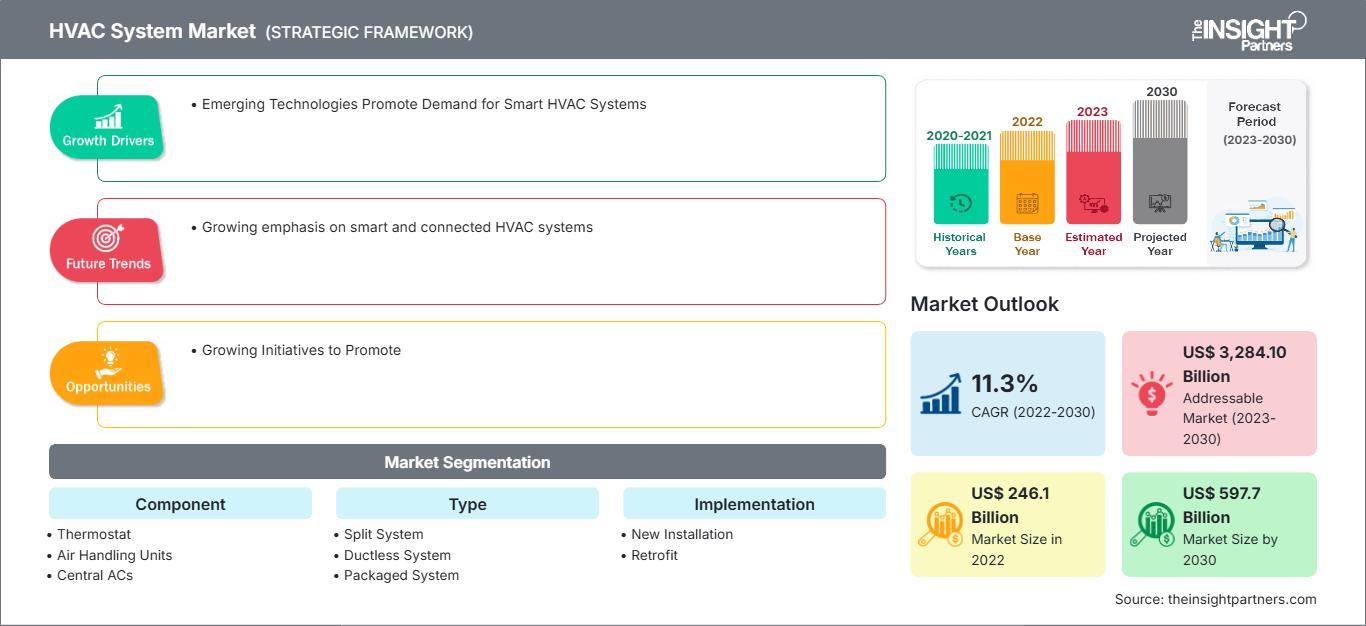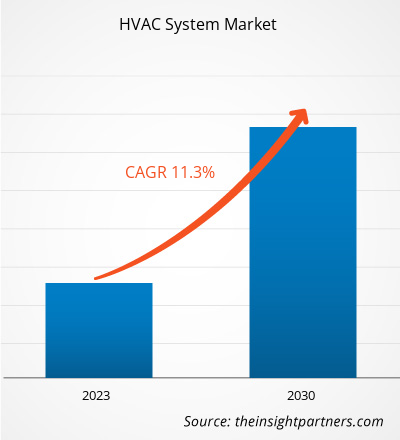暖通空调系统市场规模预计将从2022年的2461亿美元增长到2030年的5977亿美元;预计2022年至2030年的复合年增长率将达到11.3%。为了提高整体能源效率,人们越来越重视智能互联的暖通空调系统,这可能仍将是市场的一个关键趋势。
暖通空调系统市场分析
对环保型暖通空调系统和智能家居的需求激增,鼓励参与者在暖通空调技术方面进行创新开发,重点是提高能源效率。许多大型企业参与合作、收购、产品创新和发展战略。此外,2023年,暖通空调行业将转向智能互联系统。借助智能互联系统,房主和楼宇管理人员可以使用移动设备和智能手机远程控制暖通空调系统。这些系统具有精确的温度控制功能,并可根据不断变化的天气条件自动调整,以提高能源效率。此外,热泵的兴起正在改变暖通空调 (HVAC) 系统市场的前景,因为需要逐步淘汰 HFC 制冷剂。其他变革因素包括系统之间更强大的互联互通。
暖通空调 (HVAC) 系统市场概览
HVAC 是“供暖、通风和空调 (Heating, Ventilation, and Air Conditioning)”的缩写。HVAC 指的是一套完整的家居舒适系统,它可以为您的房屋供暖和制冷,同时改善室内空气质量。HVAC 有时会与 AC 混淆,然而,AC 仅指空调本身,而 HVAC 指的是整个系统,其中可能包含也可能不包含空调机组。HVAC 系统的目的是提供最佳的居家舒适环境。为此,一个完整的系统必须由空调、暖气炉、空气处理器、管道、恒温器以及可能还需要的加湿器或空气净化器等额外设备组成。
自定义此报告以满足您的要求
您将免费获得任何报告的定制,包括本报告的部分内容,或国家级分析、Excel 数据包,以及为初创企业和大学提供超值优惠和折扣
HVAC系统市场: 战略洞察

- 获取本报告的主要市场趋势。这个免费样本将包括数据分析,从市场趋势到估计和预测。
您将免费获得任何报告的定制,包括本报告的部分内容,或国家级分析、Excel 数据包,以及为初创企业和大学提供超值优惠和折扣
HVAC系统市场: 战略洞察

- 获取本报告的主要市场趋势。这个免费样本将包括数据分析,从市场趋势到估计和预测。
暖通空调系统市场驱动因素与机遇
新兴技术推动智能暖通空调系统需求
物联网设备在住宅、商业和工业领域的渗透率日益提高。暖通空调制造商正在制造智能暖通空调系统,利用无线技术与附近的智能设备通信并自动调节室内环境。智能暖通空调系统可以了解不同房间的温度或湿度,并相应地调节室内温度。它还可以根据楼层内每位成员的偏好定制室内温度。此外,这些系统可以在商业环境中节省能源,同时提供更安静的环境。此类系统可以利用人工智能 (AI) 和机器学习 (ML) 的强大功能进行改进,以实现预测性维护,从而实现更佳的成本节约和更长的使用寿命。由于这些先进技术的集成,智能暖通空调系统在住宅、商业和工业领域的应用日益普及。
推广举措不断增多
暖通空调制造商一直在与不同的生态系统公司合作,以改进其产品供应。2020 年 6 月,施耐德电气、尚飞集团和丹佛斯公司与亚萨合莱公司合作,为商业和住宅应用开发和部署无缝智能解决方案。丹佛斯公司是欧洲最大的暖通空调系统制造商之一,该公司参与此类合作将有力地促进暖通空调产品的开发。因此,合作可以为客户提供尖端的互联解决方案,例如智能暖通空调系统,从而有望对暖通空调系统市场的增长产生积极影响。
暖通空调系统市场报告细分分析
促成暖通空调系统市场分析的关键细分包括组件、类型、实施和应用。
- 根据组件,暖通空调系统市场细分为恒温器、空气处理机组 (AHU)、中央空调、暖气炉、泵、压缩机等。中央空调细分市场在 2022 年占据了最大的市场份额。
- 根据类型,市场细分为分体式系统、无管系统和成套系统。分体式系统细分市场在 2022 年占据了相当大的市场份额。
- 根据实施情况,市场分为新安装和改造。 2022 年,新安装细分市场占据了最大的市场份额。
- 根据应用,市场分为住宅、商业和工业。2022 年,商业细分市场占据了最大的市场份额。
按地区划分的暖通空调系统市场份额分析
暖通空调系统市场报告的地理范围主要分为五个区域:北美、亚太地区、欧洲、中东和非洲以及南美和中美。
2023 年,北美占据了市场主导地位。北美暖通空调系统市场分为美国、加拿大和墨西哥。北美对节能暖通空调系统的需求日益增长。消费者对能源消耗越来越敏感,并且越来越寻求有助于降低成本和减少环境影响的技术。这种需求也与监管目标和可持续发展实践相一致,为高效暖通空调设备市场提供了更多动力。
暖通空调系统暖通空调系统市场区域洞察
The Insight Partners 的分析师已详尽阐述了预测期内影响 HVAC 系统市场的区域趋势和因素。本节还讨论了北美、欧洲、亚太地区、中东和非洲以及南美和中美洲的 HVAC 系统市场细分和地域分布。
暖通空调系统市场报告范围
| 报告属性 | 细节 |
|---|---|
| 市场规模 2022 | US$ 246.1 Billion |
| 市场规模 2030 | US$ 597.7 Billion |
| 全球复合年增长率 (2022 - 2030) | 11.3% |
| 历史数据 | 2020-2021 |
| 预测期 | 2023-2030 |
| 涵盖的领域 |
By 组件
|
| 覆盖地区和国家 | 北美
|
| 市场领导者和主要公司简介 |
|
暖通空调系统市场参与者密度:了解其对业务动态的影响
暖通空调系统市场正在快速增长,这得益于终端用户需求的不断增长,而这些需求又源于消费者偏好的不断变化、技术进步以及对产品优势的认知度不断提升等因素。随着需求的增长,企业正在扩展产品线,不断创新以满足消费者需求,并抓住新兴趋势,从而进一步推动市场增长。

- 获取 HVAC系统市场 主要参与者概述
暖通空调系统市场新闻及最新发展
暖通空调系统市场评估通过收集一手和二手研究后的定性和定量数据进行,这些数据包括重要的公司出版物、协会数据和数据库。暖通空调系统市场的部分发展如下:
- Voltas 在诺伊达举办的 2024 印度 ACREX 展览会上推出了适用于商业空间的全新商用空调产品系列。新款变频涡旋式冷水机组的制冷量范围为 12-72 TR,采用环保制冷剂。该产品支持物联网 (IoT),兼容 BMS,运行安静,并且用户可以通过移动应用程序进行操作,非常方便。通过推出这款全新的变频涡旋式冷水机组,该公司旨在进一步增强其目标,即鼓励商业空间使用尖端技术,将节能解决方案融入其运营中。 (来源:Voltas,新闻稿,2024 年 4 月)
- 大金舒适技术北美公司 (Daikin Comfort Technologies North America Inc.) 推出了 Quality Install,该公司称其为使用云连接设备调试室内舒适系统的一种强大新方法。 (来源:大金舒适技术,新闻稿,2024 年 1 月)
暖通空调系统市场报告覆盖范围和可交付成果
“暖通空调系统市场规模和预测 (2020-2030)”报告提供了涵盖以下领域的市场详细分析:
- 暖通空调系统 (HVAC) 市场规模以及涵盖范围内所有关键细分市场的全球、区域和国家/地区预测
- 暖通空调系统 (HVAC) 市场趋势以及市场动态,例如驱动因素、限制因素和关键机遇
- 详细的 PEST/Porter 五力模型和 SWOT 分析
- 暖通空调系统 (HVAC) 市场分析涵盖关键市场趋势、全球和区域框架、主要参与者、法规和最新市场发展
- 行业格局和竞争分析涵盖市场集中度、热图分析、知名参与者和超导市场的最新发展
- 详细的公司简介
- 历史分析(2 年)、基准年、预测(7 年)及复合年增长率
- PEST和SWOT分析
- 市场规模、价值/数量 - 全球、区域、国家
- 行业和竞争格局
- Excel 数据集
近期报告
客户评价
购买理由
- 明智的决策
- 了解市场动态
- 竞争分析
- 客户洞察
- 市场预测
- 风险规避
- 战略规划
- 投资论证
- 识别新兴市场
- 优化营销策略
- 提升运营效率
- 顺应监管趋势




















 获取免费样品 - HVAC系统市场
获取免费样品 - HVAC系统市场